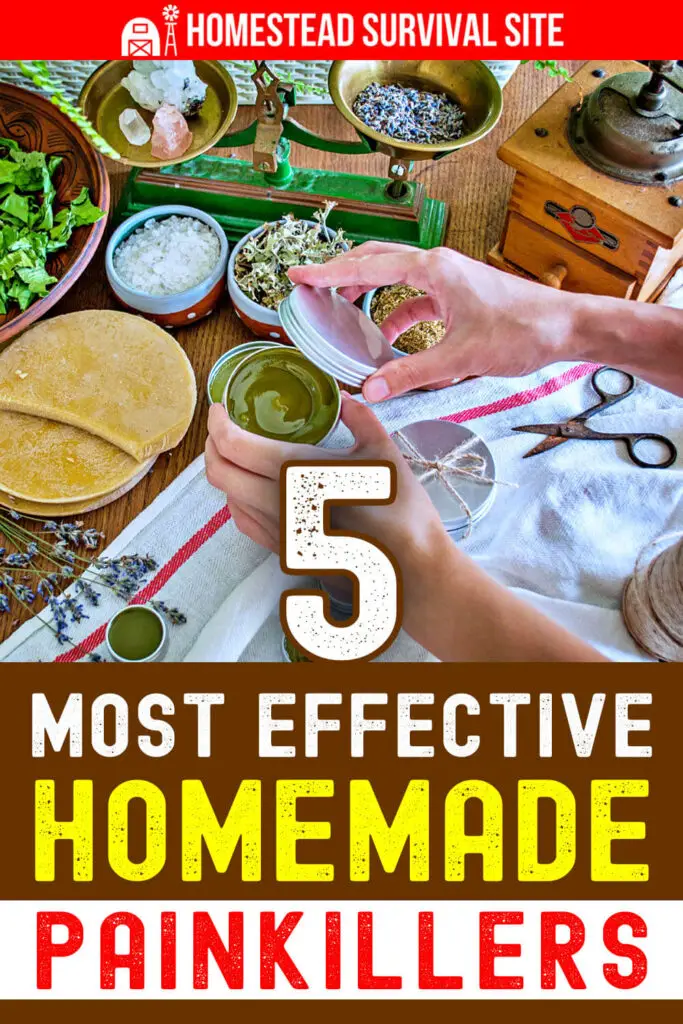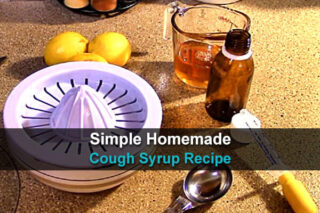Estimated reading time: 9 minutes
Disclaimer: I am not a medical doctor and nothing in this article should be taken as medical advice. Please talk to your doctor before using any of the herbs and/or remedies mentioned in this article.
The medical aspect of prepping is always the most difficult to address. Making homemade painkillers by growing or stockpiling the necessary ingredients—or both—can help prevent the folks you care about from being left to writhe in pain when sick or injured during a disaster.
Now, I am not a medical professional of any type. I am not advocating natural homemade painkillers over modern medicine, or giving medical advice. I am merely, for educational purposes, sharing what I have learned about using the bounty that nature provides to its fullest potential.
But remember, just because an item comes from nature does not mean it is safe to consume or even use topically. Also, what one person can use without negative results, another individual might have a mild or critical allergic reaction.
You should always consult your physician before embarking on any type of natural remedy routine.
Want to save this post for later? Click Here to Pin It on Pinterest!
Top 5 Effective Homemade Painkillers
1. Wild Lettuce

This wild edible has been used as a natural sedative in some regions of the world for centuries. Wild lettuce, or “lettuce opium,” as it is also known, does not literally contain opiates of any type, but users claim it has a similar effect when used as a natural painkiller.
Wild lettuce is native to Europe and Asia but can be both found growing wild or cultivated in the United States. This wild edible is most often used to alleviate pain caused by migraines and common headaches, chest congestion, whooping cough, and menstrual cramping.
Typically, wild lettuce is consumed as a tea. To make the tea, steep approximately 1 ½ to 2 tablespoons of fresh or dried lettuce. Steep the lettuce in 1 cup of boiling water for 15 minutes, then drain, keeping the liquid.
The tea should not be consumed by children, and it should only be used up to three times per day by adults. Chronic consumption of lettuce opium may have negative consequences on the brain.
This tea is not known to retain its potency for very long, so it should be made on an as-needed basis. Wild lettuce tea can be consumed either hot or cold.
2. Warming Pain Relief Salve

This topical-only painkiller is most often used to relieve pain associated with tendon and muscle injuries, back pain, arthritis, and applied to bruises to soothe pain and swelling. Here's how to make it.
Ingredients:
- 1 tablespoon of turmeric
- ¼ of a cup of beeswax – pastilles work best because they melt more quickly
- 1 cup of carrier oil – olive, almond, arnica, and coconut oil work best
- 1 tablespoon of cayenne pepper
- 1 tablespoon of ginger root powder
- 2 drops each of lavender oil and eucalyptus oil – optional, but recommended
Instructions:
- Steep the cayenne pepper, turmeric, and ginger in the carrier oil.
- Place the carrier oil in the sun for the afternoon to speed up the processing or overnight in a warm dry place.
- Strain the mixture through a fine-mesh strainer, cheesecloth, or clean cotton cloth.
- Press on the mixture to push as much of the liquid through a strainer and into a clean pot as possible.
- In a double boiler, combine the beeswax and the herbal mixture. If you do not have a double boiler, place a Mason jar, glass bowl, or coffee cup into a medium cook pot that has been filled with several inches of water and place the mixture and beeswax into the glass container or coffee cup.
- If using, stir in the essential oils now.
- Over low to medium heat only, stir constantly to avoid scorching of the mixture.
- Once the beeswax has completely melted and combined into the rest of the mixture, remove the pot from the stove.
- Pour the mixture into containers that have a firm fitting lid and allow it to both harden and cool completely before use.
Stir the warming pain relief salve in a cool dry place until needed. In my experience, it remains potent for a minimum of 12 months.
To use, simply spread onto the injured or sore area and massage in gently.
3. Golden Milk

This ancient natural and effective painkiller helps reduce or eliminate the symptoms and pain typically caused by the flu, common cold, and similar respiratory and congestion illness. Golden milk has also been used as a stress and anxiety reliever.
This rather delicious medicinal drink is turmeric-based. The recipe also includes ingredients that boast anti-inflammatory, antioxidant, and antibacterial properties. Turmeric is not easily absorbed into the body.
Using whole milk as recommended will infuse more fat content into the Golden Milk and allow for easier and more rapid turmeric absorption. Black pepper, also a recipe ingredient, greatly aids in the turmeric absorption as well.
Ingredients:
- 1/2 cup of whole milk
- 1 teaspoon of turmeric
- 1 teaspoon of raw honey
- ½ of a teaspoon of ginger – powdered spice, dried, or root
- ½ a teaspoon of cinnamon – powdered spice or grated stick
Instructions:
- Combine all of the ingredients in a medium cook pot.
- Heat the mixture to boiling while stirring constantly to prevent both a skin from forming on the top and scorching.
- Once the Golden Milk mixture has reached a rolling boil, immediately reduce the heat to just a simmer.
- Simmer the mixture for approximately 10 minutes.
- Strain the Golden Milk through a fine-mesh strainer, cheesecloth, or clean cotton cloth, keeping the liquid.
- Pour the milk into a coffee mug and sip on it to consume once it has cooled enough to do so safely.
Golden Milk can be stored in a refrigerator for approximately seven days before it begins to lose its potency and sour. Adults typically consume up to four mugs of Golden Milk per day when treating illness or stress symptoms.
4. Cloves

A toothache is never pleasant, and you do not want to endure one during a long-term disaster without some type of pain relief agent. While cloves have long been used to treat toothaches, they boast the power to relieve discomfort in many other ways as well.
Cloves have been used to treat general stomach pain, morning sickness, and gum wounds, in addition to toothaches.
Because cloves are high in calcium, potassium, fiber, magnesium, omega 3 fatty acids, phosphorus, iodine, and vitamins C and K, they possess antiviral, anti-inflammatory, and anti-fungal properties.
To use cloves as a natural and effective painkiller, simply pop a couple in your mouth and suck on them for about five minutes before spitting them out. If you have clove oil, placing several drops onto a clean cotton cloth and inhaling it may help reduce or eliminate stomach pain and morning sickness.
For a more long-lasting clove treatment, consider powdering them and mixing with a 1 to 1 ratio with honey. Once the cloves and honey are thoroughly combined, stir them into a 16-ounce glass of warm water. Sip on the water to treat any of the above-noted issues and to help stave off nausea.
5. Elderberries

Growing or stockpiling elderberries may greatly enhance your ability to treat sore throat pain and flu symptoms during a doomsday disaster. Elderberries possess more vitamin C than oranges and also are comprised of significant amounts of both vitamin A and B.
Elderberry syrup, tea, popsicles, or gummy vitamins taken regularly may help reduce symptoms of fatigue, boost the immune system and reduce the chances of getting the flu or common cold. When elderberry concoctions are used to treat sore throats, respiratory issues, and flu symptoms, they may also aid in keeping white blood cell counts to healthy levels while preventing a decreased flow of oxygen in the body.
Elderberries can be eaten raw to help garner their natural medicinal properties—they taste nice and sweet like a wild blackberry. But, you can also stockpile dried berries to be used to brew into a tea or syrup. Here's how to make it:
Ingredients:
- 1 teaspoon of honey
- 16 ounces of water
- 2 tablespoons of dried elderberries
- ¼ of a teaspoon of cinnamon
- ½ of a teaspoon of turmeric
Instructions:
- Put the water, turmeric, dried elderberries, and cinnamon, into a small or medium cook pot.
- Bring the mixture to a boil and then immediately reduce the heat to just a simmer.
- Simmer the elderberry tea mixture for 15 minutes, stirring frequently to prevent scorching.
- Remove the natural painkiller tea mixture from the stove and permit it to cool for about five to seven minutes.
- Strain the mixture through a fine-mesh strainer, cheesecloth, or clean cotton cloth to remove solids – keeping the liquid.
- Stir in the honey until it is thoroughly combined.
- Drink the tea as soon as it has cooled enough to do so safely.
The tea only retains its potency for a short while and should be made on an as-needed basis. Adults typically drink the tea up to three times a day to treat health issues.
Stockpiling the ingredients to make natural and effective painkillers should be considered as vital to your prepping as beans, bandaids, and bullets. Remaining as strong and healthy as possible is essential to your overall chances of survival.
Like this post? Don't Forget to Pin It on Pinterest!














The active ingredient in Cloves is Eugenol Oil. You can purchase the Oil at a Health Food Store to keep on hand, however it should never be directly applied to any tissue unless it’s been diluted (can be diluted with olive, grapeseed or coconut oil. Saturate a cotton ball with the diluted oil, and place between the affected tooth and the gum. Leave it in place until the pain recedes. Eugenol is the ingredient Dentists use in medicated fillings when they try to save an infected tooth.
2 items that will enhance the pain-killing properties….
1. Taking caffeine at the same time you take pain-killers. That’s why Excedrin is quite effective.
2. Eating black pepper whenever you eat or drink turmeric.
Good to know I’ve known about the caffeine for some time but not pepper
I just wanted to let you know that no one should eat raw elderberries.They have to be cooked before consumption to eliminate some toxins they contain. So this should be updated a little bit.
I love your articles and have found them extremely helpful : ) and my family uses elderberry syrup regularly with great success! Also, lots of research proves the value and helpfulness of elderberries. Just wanted to point this out so no one runs into trouble with this excellent berry which is troublesome if taken raw.
Here is a link with more information on elderberries: healthline.com/nutrition/elderberry
From that article:
“The bark, unripe berries and seeds contain small amounts substances known as lectins, which can cause stomach problems if too much is eaten.”
“In addition, the elderberry plant contains substances called cyanogenic glycosides, which can release cyanide in some circumstances. This is a toxin also found in apricot seeds and almonds.”
“There are 3 mg of cyanide per 100 grams of fresh berries and 3–17 mg per 100 grams of fresh leaves. This is just 3% of the estimated fatal dose for a 130-pound (60-kg) person.”
“However, commercial preparations and cooked berries do not contain cyanide, so there are no reports of fatalities from eating these. Symptoms of eating uncooked berries, leaves, bark or roots of the elderberry include nausea, vomiting and diarrhea.”
“There is one report of eight people falling ill after drinking the juice from freshly picked berries, including the leaves and branches, from the S. mexicana elder variety. They experienced nausea, vomiting, weakness, dizziness, numbness and stupor.”
So according to what you posted only unripe elder berries make you sick correct? The other stuff that can create cyanid in some circumstances are in many foods but the one in your post is almonds. I’m just curious as it said a certain type Mexican something in your copy and post. I’m wondering if this is true in all species? Where I live as long as they are completely ripe we eat them use in pies cough syrup and even freeze them to store and not just my family practically Every one I know and I’ve never heard of anyone getting sick unless they are not completely ripe. I’m not arguing just wondering if it’s only in unripe or certain types of elderberry plant. Other than the stuff that’s in almonds and many other foods.
Is there a way that I can just print the pages that I can use. Thank you Debbie